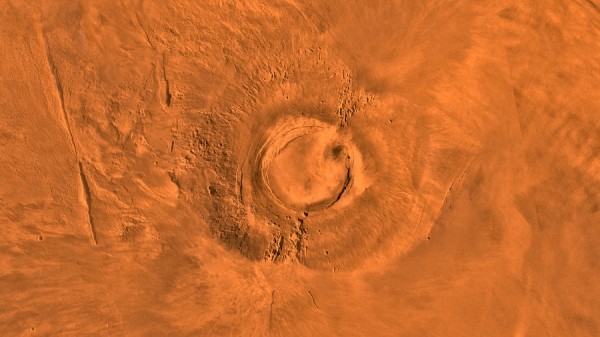By Ana Verayo, | March 22, 2017

New research using observations from NASA's Mars Reconnaissance Orbiter indicates that Arsia Mons, one of the largest volcanos on Mars, actively produced lava flows until about 50 million years ago.
Across the volcanic plateau of Mars, three volcanoes known as the Tharsis Montes have been quite active during ancient Martian times. These "shield volcanoes" are known as the Ascraeus Mons, Pavonis Mons and the Arsia Mons which was the last volcano to erupt with lava on Mars. Arisia Mons also erupted during the time when dinosaurs went extinct on Earth.
Like Us on Facebook
The Tharsis Montes was first discovered by the NASA Mariner 9 spacecraft bck in 1971, as astronomers are still trying to determine when is the last volcanic activity on Mars. Today, NASA's Mars Reconnaissance Orbiter captured high resolution imagery of Arsia Mons using the Context Camera aboard the orbiter.
In this new study, scientists suggest that the last volcanic activity on Arsia Mons occurred some 50 million years ago. Coincidentally, this is also the time when dinosaurs on Earth were wiped out by a massive asteroid impact.
According to lead author of the study, Jacob Richardson of NASA's Goddard Space Flight Center, we have estimated that the last time that the volcanic field was in its peak activity at the summit of Arsia Mons was around 150 million years years ago. On Earth, this is also the time if the late Jurassic period when dinosaurs have died out.
Richardson suggests that it is possible that the last volcanic vent could have been still active in the last 50 million years which is very recent in the geological timeline. During the study, researchers were able to map out ancient lava flows for the 29 volcanic vents across Arsia Mons. They then calculated the number of craters that are at least 330 feet wide that provided clues about the lava flows' ages.
After intensive analysis using a computer model, they discovered that the oldest lava flow dates back to 200 million years. The most recent vent eruptions and lava flows were released between 10 to 90 million years back.
This also means that during its peak activity, Arsia Mons is estimated to release around one to eight cubic kilometers of magma for every 1 million years. Richardson explains, this is similar to a very slow, leaky faucet of magma, compared to Earth, which is 10,000 years in similar volcanic regions.
These new findings are crucial in mapping out the volcanic history of the Red Planet, including understanding Martian structure and geological evolution and in general, all rocky planets including Earth. This new study is published in the journal, Earth and Planetary Science Letters.
-
Use of Coronavirus Pandemic Drones Raises Privacy Concerns: Drones Spread Fear, Local Officials Say

-
Coronavirus Hampers The Delivery Of Lockheed Martin F-35 Stealth Fighters For 2020

-
Instagram Speeds Up Plans to Add Account Memorialization Feature Due to COVID-19 Deaths

-
NASA: Perseverance Plans to Bring 'Mars Rock' to Earth in 2031

-
600 Dead And 3,000 In The Hospital as Iranians Believed Drinking High-Concentrations of Alcohol Can Cure The Coronavirus

-
600 Dead And 3,000 In The Hospital as Iranians Believed Drinking High-Concentrations of Alcohol Can Cure The Coronavirus

-
COVID-19: Doctors, Nurses Use Virtual Reality to Learn New Skills in Treating Coronavirus Patients







